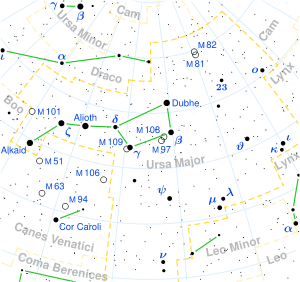Phi Ursae Majoris
 | |
| Observation data Epoch J2000.0 Equinox J2000.0 | |
|---|---|
| Constellation | Ursa Major |
| Right ascension | 09h 52m 06.35437s[1] |
| Declination | +54° 03′ 51.5962″[1] |
| Apparent magnitude (V) | +4.60[2] |
| Characteristics | |
| Spectral type | A3 IV[3] |
| U−B color index | +0.08[2] |
| B−V color index | +0.03[2] |
| Astrometry | |
| Radial velocity (Rv) | −14.70[4] km/s |
| Proper motion (μ) | RA: −6.00[1] mas/yr Dec.: +19.16[1] mas/yr |
| Parallax (π) | 6.41 ± 0.59[1] mas |
| Distance | 510 ± 50 ly (160 ± 10 pc) |
| Absolute magnitude (MV) | −1.39[5] |
| Details | |
| φ UMa A | |
| Mass | 3.5±0.2[6] M☉ |
| Luminosity | 347[6] L☉ |
| Surface gravity (log g) | 3.69±0.16[7] cgs |
| Temperature | 8,769±150[7] K |
| Metallicity [Fe/H] | −0.23±0.08[7] dex |
| Rotational velocity (v sin i) | 28[6] km/s |
| Other designations | |
| Database references | |
| SIMBAD | data |
Phi Ursae Majoris (Phi UMa, φ Ursae Majoris, φ UMa) is binary star in constellation of Ursa Major, which is separated in 0.245 arcseconds.[9] Both of components are white A-type subgiant.[10] Based upon parallax measurements, it is approximately 510 light years from Earth.[1]
Phi Ursae Majoris is moving through the Galaxy at a speed of 21.6 km/s relative to the Sun. Its projected Galactic orbit carries it between 24,000 and 46,000 light years from the center of the Galaxy.[11]
Phi Ursae Majoris will come closest to the Sun 4.7 million years from now when it will brighten to magnitude 3.88 from a distance of 370 light years.[11]
Naming
- With τ, h, υ, θ, e, and f, it composed the Arabic asterism Sarīr Banāt al-Na'sh, the Throne of the daughters of Na'sh, and al-Haud, the Pond,[12]
- In Chinese, 文昌 (Wén Chāng), meaning Administrative Center, refers to an asterism consisting of φ Ursae Majoris, υ Ursae Majoris, θ Ursae Majoris, 15 Ursae Majoris and 18 Ursae Majoris. Consequently, φ Ursae Majoris itself is known as 文昌三 (Wén Chāng sān, English: the Third Star of Administrative Center.).[13]
References
- 1 2 3 4 5 6 van Leeuwen, F.; et al. (2007). "Validation of the new Hipparcos reduction". Astronomy and Astrophysics. 474 (2): 653–664. arXiv:0708.1752. Bibcode:2007A&A...474..653V. doi:10.1051/0004-6361:20078357.
- 1 2 3 Johnson, H. L. (1966), "UBVRIJKL Photometry of the Bright Stars", Communications of the Lunar and Planetary Laboratory, 4: 99, Bibcode:1966CoLPL...4...99J.
- ↑ Edwards, T. W. (April 1976), "MK classification for visual binary components", Astronomical Journal, 81: 245–249, Bibcode:1976AJ.....81..245E, doi:10.1086/111879
- ↑ Gontcharov, G. A. (2006). "Pulkovo Compilation of Radial Velocities for 35 495 Hipparcos stars in a common system". Astronomy Letters. 32 (11): 759–771. arXiv:1606.08053. Bibcode:2006AstL...32..759G. doi:10.1134/S1063773706110065.
- ↑ Anderson, E.; Francis, Ch. (2012), "XHIP: An extended hipparcos compilation", Astronomy Letters, 38 (5): 331, arXiv:1108.4971, Bibcode:2012AstL...38..331A, doi:10.1134/S1063773712050015.
- 1 2 3 Zorec, J.; Royer, F. (January 2012), "Rotational velocities of A-type stars. IV. Evolution of rotational velocities", Astronomy & Astrophysics, 537: A120, arXiv:1201.2052, Bibcode:2012A&A...537A.120Z, doi:10.1051/0004-6361/201117691.
- 1 2 3 Prugniel, P.; Vauglin, I.; Koleva, M. (2011), "The atmospheric parameters and spectral interpolator for the MILES stars", Astronomy & Astrophysics, 531: A165, arXiv:1104.4952, Bibcode:2011A&A...531A.165P, doi:10.1051/0004-6361/201116769.
- ↑ "phi UMa". SIMBAD. Centre de données astronomiques de Strasbourg. Retrieved 18 February 2017.
- ↑ Barnaby, David; Spillar, Earl; Christou, Julian.C; Drummond, Jack.D (January 2000), "Measurements of Binary Stars with the Starfire Optical Range Adaptive Optics Systems", The Astronomical Journal, 119 (1): 378–389, Bibcode:2000AJ....119..378B, doi:10.1086/301155
- ↑ PHI UMA (Phi Ursae Majoris)
- 1 2 Phi Ursae Majoris (HIP 48402) Archived 2013-04-14 at Archive.is
- ↑ Allen, Richard Hinckley (1899), Star-Names and Their Meanings, New York: G. E. Stechert, p. 442
- ↑ (in Chinese) AEEA (Activities of Exhibition and Education in Astronomy) 天文教育資訊網 2006 年 6 月 16 日
This article is issued from
Wikipedia.
The text is licensed under Creative Commons - Attribution - Sharealike.
Additional terms may apply for the media files.